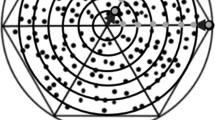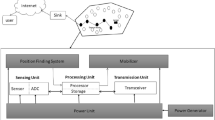Abstract
The wireless sensor network (WSN) is always known for its limited-energy issues and finding a good solution for energy minimization in WSNs is still a concern for researchers. Implementing mobility to the sink node is used widely for energy conservation or minimization in WSNs which reduces the distance between sink and communicating nodes. In this paper, with the intention to conserve energy from the sensor nodes, we designed a clustering based routing protocol implementing a mobile sink called ‘two dimensional motion of sink node (TDMS)’. In TDMS, each normal sensor node collects data and send it to their respective leader node called cluster head (CH). The sink moves in the two dimensional direction to collect final data from all CH nodes, particularly it moves in the direction to that CH which has the minimum remaining energy. The proposed protocol is validated through rigorous simulation using MATLAB and comparisons have been made with WSN’s existing static sink and mobile sink routing protocols over two different geographical square dimensions of the network. Here, we found that TDMS model gives the optimal result on energy dissipation per round and increased network lifetime.













Similar content being viewed by others
References
Agarwal, D. P. (2017). Applications of sensor networks in embedded sensor systems, chapter 1, sec. 1 (1st ed, pp. 35–63). Singapore, Malaysia: Springer.
Neethirajan, S. (2017). Recent advances in wearable sensors for animal health management. Sensing and Bio-Sensing Research, 12, 15–29.
Divya, K., Jaipriya, S., Anitha, G., Malathy, S., & Maheswar, R (2018). An energy efficient technique for time sensitive application using MC-WSN. In Proceedings of the 2nd international conference on innovative systems and control (pp. 1451–1455).
Lin, J., Yu, W., Zhang, N., Yang, X., Zhang, H., & Zhao, W. (2017). A survey on internet of things: Architecture, enabling technologies, security and privacy, and applications. IEEE IoT Journal, 4(5), 1125–1142.
Kim, H. Y., & Kim, J. (2017). An energy-efficient balancing scheme in wireless sensor networks. Wireless Personal Communications, 94, 17–29.
Louail, L., & Felea, V. (2019). Centroid-based single sink placement in wireless sensor networks. Wireless Personal Communications, 108, 121–140.
Musale, V., & Chaudhari, D (2017). Challenges, protocols and case studies in design of reliable energy efficient wireless sensor networks. In IEEE proceedings of the 4th international conference on advanced computing and communications systems (pp. 1–7)
Sharma, S., Bansal, R. K., & Bansal, S. (2014). Issues and challenges in wireless sensor networks. In Proceedings of the international conference on machine intelligence and research advancement.
Magadevi, N., Kumar, V. J. S., & Suresh, A. (2018). Maximizing the network life time of wireless sensor networks using a mobile charger. Wireless Personal Communications, 102, 1029–1039.
Heydari, R. D., & Kavand, H. (2019). Finding mobility pattern of movable target in wireless sensor networks by crowdsourcing designed mechanism. Wireless Personal Communications, 109, 963–980.
Maheswari, D. U., & Sudha, S. (2019). Node degree based energy efficient two-level clustering for wireless sensor networks. Wireless Personal Communications, 104, 1209–1225.
Hsu, H. L., & Liang, Q. (2005). An energy-efficient protocol for wireless sensor networks. In IEEE Proceedings of the 62th vehicular technology conference (pp. 2321–2325).
Kobo, H. I., Abu-Mahfouz, A. M., & Hancke, G. P. (2017). A survey on software-defined wireless sensor networks: Challenges and design requirements. IEEE Access, 5, 1872–1899.
Azad, P., & Sharma, P. (2014). Pareto-optimal clustering scheme using data aggregation for wireless sensor networks. International Journal of Electronics, 102(7), 1165–1176.
Aloulou, R., Lucas De Peslouan, P.-O., Mnif, H., Alicalapa, F., Luk, L. S., & Loulou, M. (2015). A power management system for energy harvesting and wireless sensor networks application based on a novel charge pump circuit. International Journal of Electronics, 103(5), 841–852.
Ahlawat, M., & Mittal, A. (2015). Different communication protocols for wireless sensor networks: A Review. International Journal of Advanced Research in Computer and Communication Engineering, 4(3), 2319–5940.
Heizelman, W. R., Chandrakasan, A., & Balakrishnan, H. (2000). Energy efficient communication protocol for wireless micro sensor networks. In IEEE proceedings of the 33rd annual Hawaii international conference on system sciences (pp. 10–20).
Lindsey, S., & Raghavendra, C. S. (2002). PEGASIS: Power efficient gathering in sensor information systems. IEEE Proceedings on Aerospace Conference, 3, 1125–1130.
Tabibi, S., & Ghaffari, A. (2019). Energy-efficient routing mechanism for mobile sink in wireless sensor networks using particle swarm optimization algorithm. Wireless Personal Communications, 104, 199–216.
Robinson, Y. H., Julie, E. G., Saravanan, K., Kumar, R., & Son, L. H. (2020). DRP: Dynamic routing protocol in wireless sensor networks. Wireless Personal Communications, 111, 313–329.
Yang, F., Wu, N., Zhang, C., Zhu, Y., Su, R., Qiao, Y., & (May, . (2018). Efficient approach to cyclic scheduling of single-arm cluster tools with chamber cleaning operations and wafer residency time constraint. IEEE Transactions on SEMICONDUCTOR MANUFACTURING., 31(2), 196–205.
Ge, X., Han, Q.-L., & Zhang, X.-M. (2017). Achieving cluster formation of multi agent systems under periodic sampling and communication delays. IEEE Transactions on Industrial Electronics, 65(4), 3417–3426.
Loscri, V., Morabito G., & Marano, S. (2005). A two levels hierarchy for low-energy adaptive clustering hierarchy (TL-LEACH). In IEEE 62nd vehicular technology conference (pp. 1809–1813).
Jain, A., & Goel, A. K. (2019). Energy efficient fuzzy routing protocol for wireless sensor networks. Wireless Personal Communications, 110, 1459–1474.
Thomas, S., & Mathew, T. (2018). Intelligent path discovery for a mobile sink in wireless sensor network. Procedia Computer Science., 143, 749–756.
Soni, S., & Bajpai, S. (2018). Energy-efficient clustering in wireless sensor network with mobile sink. In International conference on advanced computing networking and informatics (pp. 225–236).
Yu, S., Zhang, B., Li, C., & Mouftah, H. T. (2014). Routing protocols for wireless sensor networks with mobile sinks: A survey. IEEE Communications Magazine, 52(7), 150–157.
Awan, K., Shah, P. A., Iqbal, K., & Gillani, S. (2019). Underwater wireless sensor networks: A review of recent issues and challenges. Wireless Communications and Mobile Computing., 3, 1–20.
Tazibt, C. Y., Bekhti, M., Djamah, T., Achir, N., & Boussetta, K. (2017). Wireless sensor network clustering for UAV-based data gathering. Wireless Days.
Wang, J., Gao, Y., Liu, W., Sangaiah, A. K., & Kim, H. J. (2019). Energy efficient routing algorithm with mobile sink support for wireless sensor networks. Sensors., 19(7), 1494.
Jafri, M. R., Javaid, N., Javaid, A., & Khan, Z. A. (2013). Maximizing the lifetime of multi-chain PEGASIS using sink mobility. World Applied Sciences Journal, 21(9), 1283–1289.
Nakayama, H., Fadlullah, Z. M., Ansari, N., & Kato, N. (2011). A novel scheme for WSAN sinks mobility based on clustering and set packing techniques. IEEE Transactions on Automatic Control, 56(10), 2381–2389.
Mottaghi, S., Zahabi, M. R., & (Feb, . (2015). Optimizing LEACH clustering algorithm with mobile sink and rendezvous nodes. AEU International Journal of Electronics and Communications, 69(2), 475–608.
Gal, Z., Korteby, M. A., & Dabbas, A. (2018). Impact of the delay tolerance in wireless sensor networks. In IEEE international conference on future IoT technologies.
Kaswan, A., Nitesh, K., & Jana, P. K. (2017). Energy efficient path selection for mobile sink and data gathering in wireless sensor networks. AEU-International Journal of Electronics and Communications, 73, 110–118.
Basumatary, H., & Singh, M. M. (2018). Multi clustered energy efficient routing algorithm with mobile sink node moving in a clockwise direction. In Proceedings of international conference on recent advancement on computer and communication (pp. 645–654).
Singh, M. M., & Basumatary, H. (2017). Lifetime analysis of wireless sensor network considering stay time and stay location of the sink. CSI Journal of Computing, 3(2), 1–8.
Wang, J., Cao, Y., Li, B., Kim, H. J., & Lee, S. (2017). Particle swarm optimization based clustering algorithm with mobile sink for WSNs. Future Generation Computer Systems, 76, 452–457.
Muhammad, Z., Saxena, N., Qureshi, I. M., & Ahn, C. W. (2017). Hybrid artificial bee colony algorithm for an energy efficient internet of things based on wireless sensor network. IETE Technical Review, 34(1), 39–51.
Akbar, M., Javaid, N., Imran, M., Amjad, N., Khan, M. I., & Guizani, M. (2016). Sink mobility aware energy-efficient network integrated super heterogeneous protocol for WSNs. EURASIP Journal on Wireless Communications and Networking, 66, 1-19.
Malavenda, C. S., Menichelli, F., & Olivieri, M. (2017). Narrowband delay tolerant protocols for WSN applications: Characterization and selection guide. In International conference on applications in electronics pervading industry, environment and society (pp. 109–121).
Kumar, N., & Singh, Y. (2017). Handbook of research on advanced wireless sensor network applications, protocols, and architectures. In IGI global, 2017, chapter 4 (pp. 86–128).
Abdulhamid, Z. (2017). An efficient clustering method using weighting coefficients in homogeneous wireless sensor networks.Alexandria Engineering Journal, 57(2), 695–710.
Author information
Authors and Affiliations
Corresponding author
Additional information
Publisher's Note
Springer Nature remains neutral with regard to jurisdictional claims in published maps and institutional affiliations.
Rights and permissions
About this article
Cite this article
Basumatary, H., Debnath, A., Deb Barma, M.K. et al. Clustering Based Two Dimensional Motion of Sink Node in Wireless Sensor Networks. Wireless Pers Commun 118, 161–183 (2021). https://doi.org/10.1007/s11277-020-08007-5
Accepted:
Published:
Issue Date:
DOI: https://doi.org/10.1007/s11277-020-08007-5




